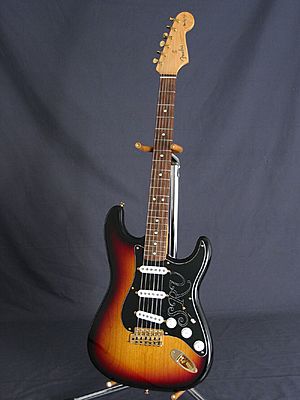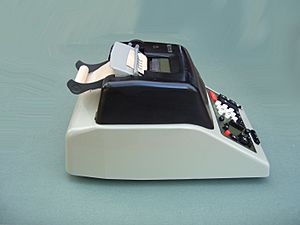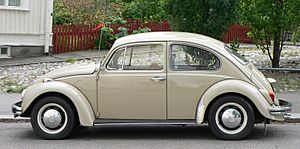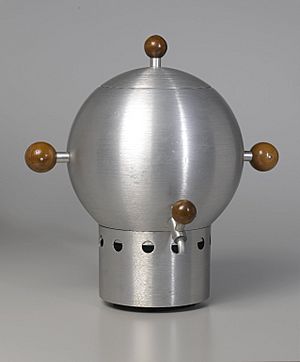Industrial design facts for kids
Industrial design is all about creating the look and feel of products that are made in large numbers. It's the creative job of deciding how a product will look and work before it's actually built. Think of it as planning the shape and features of something like a phone, a car, or a chair. This is different from old-fashioned crafts, where one person made a product from start to finish.
Every product you see that's made in a factory started with a design process. This process can be done by one person or a team. This team might include designers, engineers, and business experts. Industrial design often mixes art and science. It focuses on making products look good and be easy to use. It also helps solve problems related to how a product works, how people use it, how it's sold, and how it affects the environment.
Contents
History of Industrial Design
How Things Were Made Before
For thousands of years, before factories became common, skilled craftsmen made most products. These craftsmen designed and built things like furniture or tools all by themselves. They used their own skills, ideas from their customers, and knowledge passed down through training.
Over time, people started working together in bigger workshops. In cities like Florence and Venice, groups of craftsmen made similar objects. They followed shared designs and techniques. In the 1500s, "pattern books" appeared in Italy and Germany. These books had drawings of decorations that could be used on many different products. This was an early way of designing things before they were made. Also, drawings to show how something should be built were first used by architects and shipwrights during the Italian Renaissance.
In the 1600s, kings and queens started having large factories. A famous example is the Gobelins Manufactory in Paris, France, opened in 1667. Here, hundreds of artists and craftsmen worked together. They made fancy items like tapestries and furniture. The king's main artist, Charles Le Brun, oversaw all the creative work. This showed how design could be managed on a large scale.
The Start of Industrial Design
Industrial design really began with the industrial revolution in Great Britain in the mid-1700s. Factories and machines changed how products were made. More people moved to cities, changing how they bought things. Empires grew, bringing new tastes and markets. A growing middle class wanted stylish products, creating a huge demand.
The term "industrial design" was first used around 1919. However, the idea of it existed much earlier. Christopher Dresser is seen as one of the first independent industrial designers. The Deutscher Werkbund, started in Germany in 1907, was an early group. It aimed to combine traditional crafts with factory production. This helped Germany compete with other countries.
One of the earliest times the term was printed was in a magazine called The Art-Union in 1840. It talked about schools where students learned to design for factories. It noted that artists who designed for industrial purposes were well-paid and respected.
A book called The Practical Draughtsman's Book of Industrial Design was printed in 1853. It taught how to draw for machines, engineering, and buildings. This book helped spread drawing education in many countries.
Learning Industrial Design
Industrial design often overlaps with Product design. This includes designing how users interact with products. Most industrial designers go to a special design school or university. They can study things like graphic design or interior design.
You can get a diploma or a degree in industrial design. These programs usually take two to four years. You might earn a Bachelor of Industrial Design (B.I.D.) or a Bachelor of Fine Arts (B.F.A.). After that, some students go on to get a Master's degree.
What Industrial Design Is About
Industrial design looks at how a product works and how it looks. It also considers how the product, the person using it, and the environment connect. Industrial designers usually work on smaller products, not huge things like buildings or ships. They don't typically design the inner workings of machines, like motors. But they do make sure the product is easy and enjoyable to use.
Designers often work with engineers. Engineers focus on how the product works and how it can be made. Designers also work with marketing teams. Marketers help figure out what customers need and want.
One simple way to think about design is: "Everyone designs who plans actions to change existing situations into better ones." This means design is about making things better, whether they are new or already exist.
Industrial design is different from engineering design. Engineering mainly focuses on how products work. Industrial design focuses more on how products look and how people interact with them. In many places, engineers need special licenses, but industrial designers usually don't.
In 2015, a group of design experts gave a new definition for industrial design. They said: "Industrial Design is a smart way of solving problems. It helps create new ideas, makes businesses successful, and improves life. It does this through new products, systems, services, and experiences."
They also added that industrial design helps bridge the gap between what is now and what is possible. It uses creativity to solve problems and create solutions. It aims to make products, services, or businesses better. Industrial designers put people at the center of their work. They try to understand what users need and then design solutions that are practical and user-friendly.
The Design Process

Even though design is creative, it also involves a lot of thinking and planning. Industrial designers use different methods in their work. These can include:
- User research: Finding out what people need.
- Sketching: Drawing ideas quickly.
- Comparing products: Looking at similar products already out there.
- Model making: Building small versions of the product.
- Prototyping and testing: Creating working samples and trying them out.
Designers often use 3D software and computer programs to help them. They might also build a 3D printed prototype. Or they might use materials like paper, wood, or clay for models.
Industrial designers decide many things about a product. This includes its overall shape, where details are placed, colors, textures, and how easy it is to use. They also think about how the product will be made and what materials to use. Including industrial designers can make products better, cheaper to make, and more attractive to buyers.
Industrial design also considers technical ideas and processes. Besides looks and usability, it can involve engineering, how useful something is, and how it fits in the market. It can even look at how people feel about a product.
Working with Others (Co-Design)
Recently, industrial designers have found new ways to work. They often work in small teams with people from different jobs. This is called participatory design or co-design. For example, a designer creating a prosthesis (an artificial body part) might work with a patient and a prosthetist. This way, everyone is actively involved in the design process. They don't just rely on others for information.
Thinking About the Bigger Picture (Fourth Order Design)
Beyond just the product itself, designers now think about many other things. This includes how a product affects society, the economy, and the environment. It also considers things like mental health. This way of thinking helps designers understand that a product doesn't exist alone. It's part of many connected processes.
For example, after Hurricane Sandy caused a lot of damage, a competition called Rebuild by Design was held. Designers were asked to find ways to protect New York from future storms. One idea, called The Big U, involved building flood gates and walls. This would protect parts of Manhattan from rising sea levels. Another idea, Living Breakwaters, aimed to build structures in the water. These would help marine life and protect the coast.
The Big U project is now being built. It includes flood protection and better access to parks. It also upgrades sewer systems and improves open spaces for many New Yorkers. This shows how designers are thinking about the community. They are considering how their work affects people's lives.
Industrial Design Rights
Industrial design rights are like intellectual property rights. They protect the unique look of a product that isn't just about how it works. This means the shape, pattern, or colors of a product can be protected. A design patent is an example of this.
You can register an industrial design internationally. This is done through a treaty called the Hague Agreement Concerning the International Deposit of Industrial Designs. You can file one application and protect your design in many countries that are part of the treaty.
Famous Industrial Designs
Many industrial designers have created products that changed culture and daily life.
- Alvar Aalto, known as an architect, also designed many household items. These include chairs, lamps, and vases.
- Raymond Loewy was a very busy American designer. He created logos for companies like Royal Dutch Shell. He also designed trains, cars like the Studebaker Starlight, and everyday items like razors and refrigerators.
- Richard Teague worked for American Motors Corporation. He came up with the idea of using parts that could be swapped between different car models. He designed cars like the AMC Pacer and the Jeep Cherokee.
- Brooks Stevens designed the Oscar Mayer Wienermobile.
- Viktor Schreckengost designed bicycles and the first truck with a cab-over-engine design.
- Oskar Barnack invented the Leica camera. This camera became very important in photography for 50 years.
- Charles and Ray Eames are famous for their furniture designs, like the Eames Lounge Chair.
- Dieter Rams is a German designer known for his work with the company Braun. His designs are simple and functional.
- German designer Luigi Colani designed cars for companies like Fiat and BMW. He was known for his unusual designs, from household items to a grand piano.
- Sir Jonathan Ive designed many of Apple's well-known products, like the iPhone and iPad.
Images for kids
See also
 In Spanish: Diseño industrial para niños
In Spanish: Diseño industrial para niños
- Automotive design
- Designer
- Product development
- Product design
- Rapid prototyping
- Form follows function
- Sustainable design
- Interaction design









